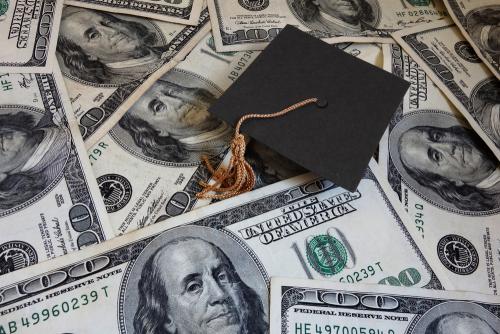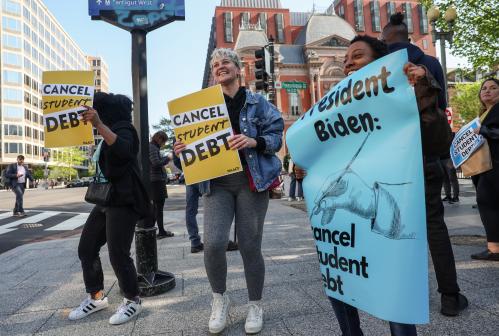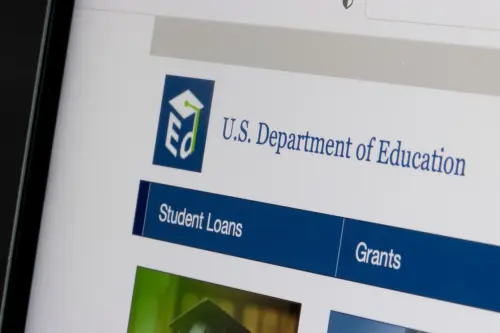Since March of 2020, payments and interest accumulation on most federal student loans have been paused. This “payment pause” provided immediate relief to millions of households with student loan debt at a time of great economic uncertainty due to the pandemic. Since then, the Biden-Harris administration sought to use executive action to forgive $10,000 to $20,000 in student loans for most borrowers and, when that was put on hold by courts last November, extended the loan pause for the eighth time. The fates of both the debt forgiveness plan and the loan pause are now legally uncertain and an end of the payment pause before the fall of 2023 is a scenario for which the Department of Education (ED), advocates, and borrowers must prepare.
Some student loan borrowers have high incomes and never suffered wage losses due to the pandemic, and rising wages and low unemployment mean that many borrowers have recovered from any short-term financial effects of the pandemic. Other borrowers—particularly those who were struggling with student loan payments before the pandemic—will face significant financial hardship with the restart of payments.
For borrowers who are likely to struggle, relief through the loan cancellation plan proposed by the Biden administration is by no means assured while a further extension of the payment pause appears unlikely given ongoing litigation. For this reason, helping eligible borrowers enroll in existing programs that could help protect them from financial distress when payments resume needs to be the immediate priority for the Department of Education, along with the legislative branch of government. Doing so would not only mitigate hardship associated with the restart of payments, but it would also contribute to structural improvements in the administration and integrity of the federal student loan program.
Other borrowers—particularly those who were struggling with student loan payments before the pandemic—will face significant financial hardship with the restart of payments.
An unhealthy marriage: Student loan debt forgiveness and the payment pause
With the declaration of the COVID-19 pandemic as a national emergency in March 2020, then-President Trump used executive authority to waive interest and suspend student loan payments on all government-held student loans, effectively allowing penalty-free forbearance. Congress subsequently required the U.S. Secretary of Education to extend payment suspension on most federal student loans until September 30, 2020 in the Coronavirus Aid, Relief and Economic Security Act (CARES). The Trump administration extended the payment pause until December 31, 2020, and then again until January 31, 2021. From the time he took office in January 2021 until the end of 2022, President Biden extended the payment pause six more times. These executive actions relied on the Higher Education Relief Opportunities for Students Act of 2003, known as the HEROES Act, which provides executive authority to modify the terms of student loans for those who are affected by “a war or other military operation or national emergency.”
In August of 2022, the Biden administration announced a proposal to forgive up to $20,000 in federal student loan debt per borrower by executive action and at the same time announced yet another extension to the loan pause. Under the debt forgiveness proposal, up to $10,000 in debt would be cancelled for borrowers with incomes below $125,000 (or $250,000 for a married couple). Up to $20,000 in student loan debt would be cancelled for borrowers who received Pell grants during college (which are only available to lower-income borrowers) and also met the income requirements.
For many Americans, the announcement of the loan forgiveness proposal may have reduced concerns about the end of the payment pause. Especially among the estimated 20 million borrowers for whom loan balances would be reduced to zero under the proposed loan forgiveness plan, the announcement likely deterred planning for the restart of payments markedly.
But the prospects for loan forgiveness are uncertain: the proposal was challenged in court almost immediately, and less than a month after the Department of Education began accepting applications for loan forgiveness in October 2022, a federal court issued a nation-wide injunction, blocking the program in November, and the application portal shuttered thereafter.[1]
The fate of the debt forgiveness plan now rests with the Supreme Court, which heard arguments on February 28, 2023, with an opinion likely forthcoming sometime in the spring or early summer. Under the terms of the current pause, payments are scheduled to resume 60 days after the Supreme Court decides the case but no later than September 1, though the administration could face pressure to extend the pause if the Supreme Court does not allow the forgiveness plan to proceed.
Meanwhile, a new court challenge brought by the private loan provider SoFi may uncouple the payment pause from the proposed debt cancellation. The plaintiff in this case is in the business of refinancing federal student loans (historically offering rates more favorable than those available in the federal student loan program for those with high incomes and good credit) and alleges that the most recent extension would lead to losses of $30 million if it were to continue through August. SoFi argues that the eighth extension exceeds the authority granted under the HEROES Act and did not follow proper “notice-and-comment” procedures. They are asking for the pause to be overturned and argue that, at a minimum, borrowers who are not eligible for loan forgiveness under Biden’s plan should be required to resume payments. If SoFi wins, it seems unlikely that the Biden administration could extend the pause again, and the payment pause could end earlier than currently planned.
The payment pause is expensive and regressive
Most policy discussions have focused on the cost of Biden’s proposed loan forgiveness plan, which estimates suggest will be around $400 billion over ten years.[2] But pausing payments is also expensive: The Committee for a Responsible Federal Budget (CRFB) estimates that pausing repayments on students loans costs about $5 billion per month. The total cost of the loan payment pauses since Spring of 2020 is estimated at around $195 billion. [3] The payment pause is also appreciably less progressive than the proposed loan forgiveness plan, with households (and individuals) in the upper part of the income distribution benefitting disproportionately.[4]
The payment pause especially benefits high-income households because they tend to have larger student loan balances—and therefore higher payments. This is particularly true when interest rates are relatively high because borrowers can accrue interest on savings that would have otherwise been spent on loan payments, while future payments are fixed in nominal dollars. Borrowers who earned graduate or professional degrees tend to have both higher loan balances (because they borrow more than undergraduates) and higher incomes (because many graduate degrees have high returns) than those with a bachelor’s degree or less. As a result, while households across the income distribution benefit from pausing payments and interest, the total value of the pause is largest for households in the top deciles.[5]
The total cost of the loan payment pauses since Spring of 2020 is estimated at around $195 billion.
Figure 1 illustrates this dynamic; it shows estimates of the distribution of households with student loan debt (the dark blue bars) and the value of total student loan payments (the light blue bars) by decile of family income from the year before payments were paused (see my work with Diego Briones and Eileen Powell for more detail about how we make these estimates).

Households with student debt are concentrated in the middle of the income distribution; about 71% of households with outstanding debt have incomes that place them in the middle 60% of the income distribution. Loan payments, on the other hand, are concentrated among households in the top of the income distribution. Without the pause, households in the top 40% of the income distribution (corresponding to family incomes above about $80,000) would account for about 60% of student loan payments but only 41% of borrower households. By contrast, households in the bottom 20% (corresponding to incomes below about $30,500) account for account for about 13% of borrower households but only 5% of payments.
While the benefits of the payment pause have already been delivered, the future of the more progressive loan forgiveness plan faces significant judicial uncertainty and may never come to pass.
Many borrowers will struggle when the payment pause ends
Most borrowers could afford to resume payments on their full balance (even if they would prefer not to), but a significant minority of borrowers have earnings too low to repay their loans. For example, some borrowers may have had worse-than-expected college outcomes, been affected by the pandemic, experienced a change in family circumstances, or suffered a financial shock. These kinds of unanticipated adverse outcomes provide a strong rationale for insurance mechanisms, such as Income Driven Repayment (IDR)[6], that are structured to reduce payments (even to zero) when a borrower’s income is low.
Survey and credit bureau data provide a sense of how many student loan borrowers will face significant hardship when payments restart. At the end of 2019, nearly 17% of the federally managed student loan portfolio in repayment status was delinquent (about 3.31 million borrowers), with payments past due more than 30 days.[7] A large fraction of those borrowers would likely continue to face hardship with a restart of payments in 2023, while some of the 2.7 million borrowers whose loans were in forbearance status at the start of 2020 are also likely to struggle with repayment owing to medical or financial difficulties. A 2022 analysis of the New York Fed’s Survey of Consumer Expectations asked respondents with paused student loan payments to consider the likelihood of delinquency were payments to resume in a month; these borrowers predicted 16.1% risk of delinquency in this scenario, with somewhat higher rates expected for non-white, female, and middle-aged borrowers.
While the benefits of the payment pause have already been delivered, the future of the more progressive loan forgiveness plan faces significant judicial uncertainty and may never come to pass.
This hardship is neither inevitable nor unavoidable. The Department of Education has a portfolio of programs available to provide relief to these borrowers which include Income-Driven Repayment (IDR), Fresh Start to Repayment, Public Service Loan Forgiveness (PSLF), and Borrower Defense to Repayment. Yet, the number of borrowers in income-based repayment programs has increased only slightly since the pandemic began, even though many more borrowers would benefit from these programs than have enrolled.[8]
Three problems are presently limiting take-up of these programs: 1) uncertainty among borrowers about the likelihood that payments will restart without loan forgiveness in place, 2) the need to take proactive steps to enroll, and 3) limited resources and tools available for the Office of Federal Student Aid (FSA) and loan servicers to facilitate borrower take-up of relief programs. The way that the timing of the end of the loan pause has become tied up with the politics of loan forgiveness has exacerbated the long-standing problem of getting struggling borrowers enrolled in programs that might provide relief.
Overconfident promises from the Biden administration about the likelihood of loan forgiveness have likely made existing relief programs less salient to borrowers.[9] And the blatantly partisan tone of many communications with borrowers have surely diminished bipartisan support for providing administrative funds to FSA. For example, Congress denied additional funding to the FSA in the December 2022 omnibus spending bill, limiting FSA’s ability to improve antiquated processes and address other problems with the income-driven programs. Some interpreted the move as a response to the large proposed expenditure on loan forgiveness and roll-out of the loan forgiveness application shortly before the mid-term elections.[10]
During the Biden administration, the Department of Education has delivered some notable accomplishments, including changes in processes and guidance intended to increase access to relief programs. Such changes include the PSLF waiver, which was in effect from October of 2021 to October of 2022 and aimed to provide retroactive access to loan cancellation for those who had qualified for loan forgiveness but failed to navigate the onerous application process. Still, it appears that take up of this program was hindered by limited administrative capacity and troubleshooting resources. A plan announced in April 2022 would effectively make many borrowers eligible for IDR retroactively, which would forgive balances or reduce payments for millions of long-term borrowers.[11] But the potential of such efforts has not been realized because FSA and the Department of Education have not issued the necessary procedural guidance that borrowers need in order to make decisions about different loan repayment and relief options.
In addition to the politically contentious debt forgiveness program, the Biden administration proposed significant administrative changes to Revised Pay as you Earn (REPAYE), one of the existing IDR plans.[12] Higher education policy experts have presented evidence demonstrating that the cost additions of this plan significantly outweigh the benefits and recommended that the proposal be adjusted to improve the targeting to low-income borrowers. A comment, along with recent testimony, from Adam Looney argue the cost of the proposed changes may be understated by as much as $360 billion. With the Notice of Proposed Rule Making put forward in January and the comment period drawing 13,635 comments, it is unlikely that ED will be able to provide responses, implement changes, and promulgate the rule before the end of 2023. The result is that the payment pause may end before the new REPAYE plan is online.
Focusing borrower attention and ED staff time on the politically and legally uncertain debt forgiveness plan, along with proposed changes to REPAYE, likely distracts from the foundational objective of providing access to the safety net of existing programs for borrowers who may struggle with the restart of payments. Providing positive user experiences, facilitating effective troubleshooting, and promoting take-up of existing programs requires bandwidth and administrative resources. “Borrower relief programs that are “on the books” could help borrowers if they know to enroll and are able to navigate the confusing procedures to do so. Rather than making false assurances about the prospects for forgiveness, ED should use the remainder of the pause to ensure that borrowers are able to access the safety net of resources designed to help those who are likely to struggle when payments resume.
Proactive efforts to smooth the restart of payments are badly needed
Regardless of one’s view on the merits of Biden’s loan cancellation plan, it is dangerous to ignore the substantial likelihood that judicial rulings will end the payment pause, strike down cancellation, or both. Failing to prepare at-risk borrowers for these outcomes is irresponsible and may inflict more harm on those who have already spent years struggling with burdensome student debt.
In the short run, what can be done to help borrowers prepare for a payment restart?
First, every available tool needs to be deployed to provide borrowers with clear information and tools to enroll in IDR and other programs designed to assist struggling borrowers. Such resources must include hands-on troubleshooting assistance, not just text messages and boilerplate email. There is ample evidence from before the pandemic that IDR enrollment reduces delinquency and increases repayment. Yet, the burdensome process of income certification likely deters many individuals from enrolling or persisting in IDR repayment plans.
Providing meaningful support to help borrowers understand their obligations and navigate different application requirements requires designating resources to FSA. Connecting borrowers with programs like Fresh Start and IDR is critically important to provide a pathway to permanent relief. Congress can release funding that would allow FSA and loan servicers to manage an orderly restart of payments and a clear path to relief for those likely to struggle to make their payments.
There is also an opportunity for others—including states and employers—to help borrowers navigate student loan repayment. Just as employers help employees navigate their health insurance and retirement plan choices, they could provide information about student loan repayment and help employees complete the “Income Verification” and “Employment Certification” required to access relief under the IDR plans or PSLF. Borrowers, employers, and communities all benefit when borrowers avoid financial distress.
Beyond the immediate period involving payment restart, the administration of the federal student loan portfolio needs a complete overhaul.
As manager of the $1.6 trillion dollar student loan portfolio, FSA approaches the scale of Citibank or Wells Fargo. Yet, FSA is under-resourced, making it impossible to provide adequate customer support and deploy other “front-end” and “back-end” resources necessary to manage a large consumer credit enterprise. FSA needs a large infusion of resources and a new strategic plan for modernization.
Effective administration of federal student loans also requires a stable administrative structure insulated from political manipulation. In this regard, FSA functions are similar to those of the Internal Revenue Service or the Social Security Administration. Innovation, not just minimally functional bureaucracy, is needed for FSA to provide the type of “user experience” that helps individual borrowers to navigate repayment plans.
Generating long-term security and stability for student loan borrowers and structuring federal student loan policies that are fiscally sound requires a new approach from the Biden administration along with the legislators from both sides of the aisle. Setting the terms of student loan repayments by executive action and judicial intervention is a recipe for disaster. Even with razor-thin majorities in both the Senate and House of Representatives, a legislative response is imperative to build a well-functioning and fiscally responsible student loan system for the long-term.
Footnotes:
[1]: On October 21st, the 8th Circuit Court of Appeals in St. Louis placed a temporary hold on the program in the Nebraska v. Biden case, while the Department of Education continued to encourage applications. On November 10th, however, a federal judge in Texas blocked the loan forgiveness policy, and the 8th Circuit Court of Appeals in St. Louis followed with an injunction on November 14th. The Biden Administration then stopped accepting applications for loan forgiveness, but pre-emptively “approved” many existing applications and communicated this to borrowers.
[2]: The Department of Education estimates that the program would cost $379 billion over 30 years.
[3]: These are underestimates of the total cost of the pause because they do not account for the fact that government liabilities under the Public Service Loan Forgiveness (PSLF), Income Driven Repayment (IDR), and similar programs are higher because individuals have accumulated qualifying payment credits towards forgiveness with zero dollar payments.
[4]: The primary estimates of the progressivity of Biden’s proposed loan forgiveness come from the White House announcement which states that “nearly 90% of debt cancellation benefits will go to borrowers earning less than $75,000” which references U.S. Department of Education Analysis. Because the plan (and the calculation) allow a married individual to use a household income threshold which is twice the individual threshold, many of the married borrowers counted in this statistic will be from families with incomes in the range above $75,000 and less than $150,000. As a point of reference, a household income of $150,000 is in the 9th decile of family income. Estimates show that more than 65% of the benefit of the payment pause has accrued to families with incomes above $75,000 and 23% to families with incomes above $150,000; still, it is difficult to compute a payment pause figure that is directly comparable to the White House figure for cancellation. See analysis by Briones, Powell, and Turner for further detail.
[5]: To illustrate, a borrower with a $500 monthly payment would have been able to save $18,000 in payments over 36 months. When interest rates were near zero (as they were at the start of the pandemic) growth of this savings was modest; but interest rates are rising, for example, short-term treasury bill returns have exceeded 4.5% in 2023.
[6]: Income Driven Repayment is an umbrella term for that applies to four distinct plans available to borrowers with federal student loans– Pay as You Earn (PAYE), Revised Pay as you Earn (REPAYE), Income-Based Repayment (IBR) and Income-Contingent Repayment (ICR). These plans differ in the length of the repayment period, the types of loans that are eligible and the percentage of income above the income protection allowance that borrowers are required to pay.
[7]: This delinquency measure is based on loans that are not in grace period, forbearance, or in-school deferment that have not been classified as defaulted.
[8]: The number of borrowers in the REPAYE program increased from 3.10 million in the 2nd quarter of 2020 to 3.37 million in the 3rd quarter of 2022; the number of borrowers in the PAYE program increased from 1.47 million in the 2nd quarter of 2020 to 1.53 million in the 3rd quarter of 2022.
[9]: For example, in November, the Department of Education sent an email to many borrowers who had completed the online application under the signature of Secretary Cardona which included: “We reviewed your application and determined that you are eligible for loan relief under the Plan….” After acknowledging that the lawsuits which blocked immediate discharge of debt, the message continued “We believe strongly that the lawsuits are meritless, and the Department of Justice has appealed on our behalf.” A face value reading of the communication might give readers the impression that the lawsuits are likely to be dismissed. Then, in the release extending the payment pause on November 22, Secretary Cardona states “We’re extending the payment pause because it would be deeply unfair to ask borrowers to pay a debt that they wouldn’t have to pay, were it not for the baseless lawsuits brought by Republican officials and special interests.” Later, in a December letter from FSA to all borrowers, the Department of Education wrote “Why are we extending the pause? Because earlier this year, the Biden-Harris Administration announced a student debt relief plan for working and middle-class borrowers. Millions of Americans applied and were found to be eligible for relief. But lawsuits challenged the program and froze our ability to finalize debt relief… We are confident that our program is legal…”
[10]: While more than $100 million was budgeted for the roll-out of the forgiveness application, there has been no comparable expenditure to increase take-up of programs that are “on the books” to help at-risk borrowers. Michael Stratford cites a Department of Education disclosure to OMB on the expected cost of building out the form for student debt relief, processing applications and related communications.
[11]: The plan adjusts payment counts, recognizing time in forbearance and other payments that would not otherwise be counted as eligible for IDR.
[12]: The Biden proposal to change the REPAYE IDR program was introduced along with the debt cancelation program in August 2022 and full proposed regulations were released in January 2023. Some of the proposed changes include raising the income protection allowance on repaying federal student loans to 225% of the poverty line, reducing the repayment rate from 10% to 5% for undergraduate borrowers and shortening the time to repayment for borrowers with modest loan balances.
The Brookings Institution is committed to quality, independence, and impact.
We are supported by a diverse array of funders. In line with our values and policies, each Brookings publication represents the sole views of its author(s).







Commentary
Student loan pause has benefitted affluent borrowers the most, others may struggle when payments resume
April 13, 2023